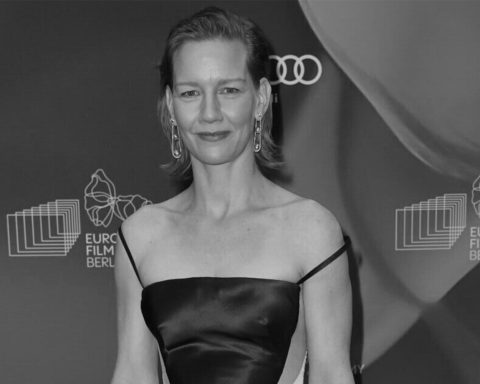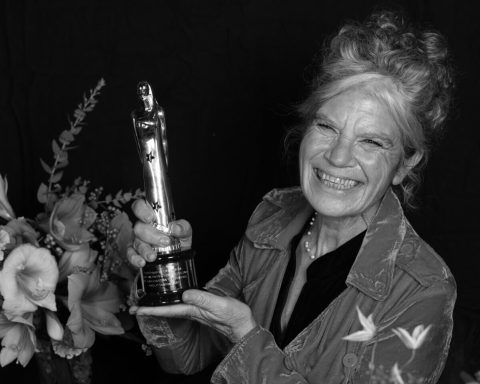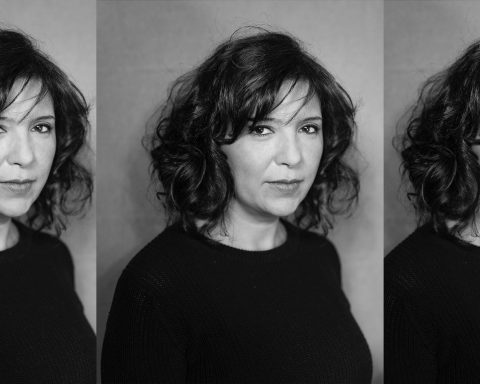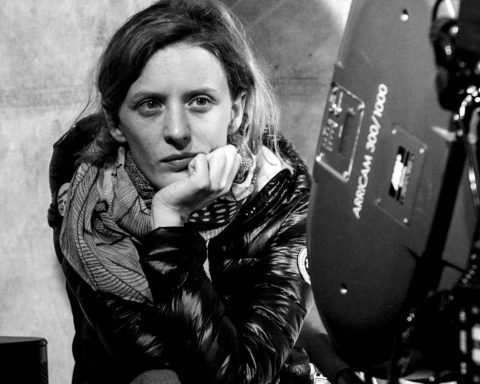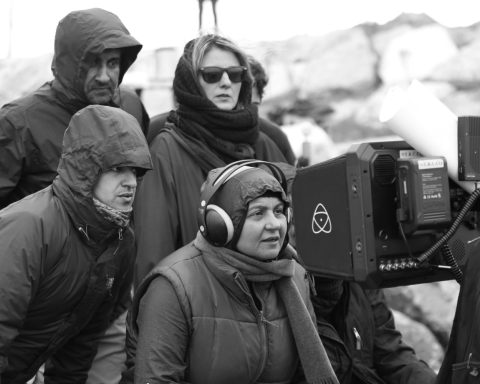Alina Grigore’s debut as an actress was in Radu Potcoava’s “Happy Ending.” After four years of acting in TV series, she worked with Romanian directors such as Cristi Puiu and Adrian Sitaru. She began researching script development and directing with director Adrian Sitaru and her students for the film “Illigitimate.” With the InLight Center, she directed, in 2013, the TV Series pilot, “The American Dream” for the Romanian Television in Chicago, and the shorts “Domino” (2016), “Triptic” (2016) and “River-Bet” (2017). She is a 2018 Berlinale Talents alumna.
Tara Karajica talks to Alina Grigore about feminism and film and her gripping debut feature, “Blue Moon,” where a young woman rebels against her dangerously dysfunctional family. The film premiered in the Official Competition at the 2021 San Sebastián Film Festival, where it won the Golden Shell for Best Film, and after successfully touring the festival circuit, is now screening in the Europe! Voices of Women in Film program at this year’s Sydney Film Festival.
How did you get into filmmaking?
Alina Grigore: In a way, research got me into filmmaking. Ten years ago, I founded the Inlight Center, a Film School where the main activity is teaching acting. And, that’s because, while I was an actress, I missed the way we were working as students at UNATC (National University of Theatre and Film I.L. Caragiale, Bucharest) and that was researching the story and our characters in a deep and insightful way. I couldn’t find that way of approaching acting when I stepped into the real world. Sitaru was the only film director in Romania truly involved in working with the actors. So, Inlight became a research hub for acting techniques and storytelling. And so, besides being a teacher there, I was always very curious to understand how the actors’ and directors’ brains work. What are the psychological mechanisms involved in the acting and writing processes? Pedagogy pushed me fast towards stage directing. And, in 2014, the director Adrian Sitaru paid us a visit as he was interested in our technique and proposed that we worked the same way on a film. I think what InLight brought to the character research is that we invite the team of actors to work together in the process of researching their characters’ past and relations. Sitaru proposed I work with the actors and so, Illegitimate was born. After that, Sitaru encouraged me to do filmmaking and I started with a couple of very experimental shorts and then Blue Moon. Blue Moon was developed in the same manner. After having written the script, we worked with the actors for a very long time, involving the editor and the DOP from a very early stage of the process.
How did Blue Moon come about?
A.G.: When I was five, I moved from Bucharest to the countryside of Romania and became a very young observer of a pretty violent and manipulative world. I was one of the few children there able to pursue further education. Later, I came back to that place and realized nothing had changed. Even more, now the parents were absent due to the huge number of emigrants. I started to document some stories there and those girls threw me into a rollercoaster of emotion.
Blue Moon follows a young woman on a psychological journey to a dehumanizing process and her relationship with and within her highly dysfunctional and violent family. Can you comment on that?
A.G.: While I was documenting the stories in my community, I realized the story itself was not as interesting without the psychological process and the emotional road that the girls were on while telling me their stories. I couldn’t find a storyline in their recollection, but the emotional road was very powerful… And dark. So, one of my biggest desires now was to be able to avoid a classical story about a girl and to visually represent the story in a manner that resembles what I felt when I was listening to those girls’ stories, and that was representing it in an emotional way. The storyline became much less important. So, one day I had to decide that I didn’t know what my stories were about, but I knew that I wanted to represent them in an emotional and intricate way, just the way our mind is built when telling a traumatic story. So, I decided that the film would be about her psychological journey, even if it’s an amalgamate and not classical.
What I find interesting is that the ambiguous sexual encounter with a married artist will prompt Irina’s intention to fight the violence in her family and as a fathomable path to freedom, showing how she decides to make the most of this encounter and embarks on an affair with the aforementioned man. It’s very far away from the #metoo mentality, reaction and movement. Can you elaborate on that?
A.G.: Irina doesn’t only fight the violence in her family, but the very subtle violence of the man who stole her virginity. What she finds is a way to truly fight it even if that dehumanizes her. She finds the courage to climb on her aggressor to reach her purpose to go away, but in the end, she remains a victim in the victim-protector-aggressor triangle. We actually filmed another final scene where she’s in the train station leaving that world behind, but we decided to show things the way they are in Romania and probably around the world – the victim will return to her aggressors and will take the back-and-forth path many times.
Not only is the film edgy and provocative, but it also attacks the senses in a way, making it difficult to follow at times. There are too many characters and it’s hard to keep track of who is parent, cousin, sibling to whom. But you very deftly and intelligently play on this mayhem and succeed in conveying to the viewers the scope of just how overwhelmed Irina is by her family that makes it its business to be her whole world while making their own laws. Can you delve deeper into that?
A.G.: It was very hard for us in the editing process to lose her in the amalgam of her family and we took that risk. We actually went back to the sound studio to try and make the relationships as unclear as possible. The family together with the sexual aggressor had to be a collective character representing the aggression and the manipulation around her. I took a huge risk for a debut film to do that and I am still not sure we managed to get to our purpose, but the very good collaboration between us and the DOP played a very important role. We decided to blur those amazing mountain surroundings just to be able to create a very introverted and suffocated Irina that cannot deal with her exterior. It was a hard decision in terms of how to represent Liviu, the aggressive cousin and, in the end, we decided that any victim in the film would be surrounded by an unsharpened background so when Liviu becomes Irina’s victim, he is treated in the same way.
Can you talk about the female characters in the film, particularly Irina? How do you see them?
A.G.: Most of them are either victims or supporters of the aggressors. While researching the victims thinking mechanisms or the Stockholm Syndrome, I was very curious about the mechanism that we all have in this victim-protector-aggressor triangle. Inside this, we keep exchanging places, and this process drags us into returning to a safe place. The safe place is the one we know, so even if it’s the aggression, it’s the best we have. Why all this happens was very important for me and I tried to put that in each of the female characters. The males tend to be the aggressor in this story, but if we look at them carefully, the only thing that is different from the female characters is the speed of transcending from one characteristic to another. Their process is slower.
Can you talk about the casting and shooting processes?
A.G.: I worked with actors and team members that I already knew from previous projects. It was my debut film, so I had to feel supported in the process. I knew a lot about their talent and professionalism, but mainly about their human character. I am usually very careful to avoid geniuses a**holes and I am very obsessed with teamwork, good communication, and collaboration. I prefer a very humane team member to a very talented one. But here, I got lucky enough to have a cast that was both talented and empathic. Ioana Chițu is an amazing actress and an activist in many ways. Gabi Suciu is by far one of the best professionals I have worked with. Mircea Postelnicu is a strong empathic actor, extremely mindful with those violent scenes.
Can you talk about the sound design, which can almost be considered a character in and of itself?
A.G.: Yes, it was the longest process of all as it had to represent the victim’s mind, be it Irina or Liviu. We worked a lot on trying to find the thin line between realism and the emotional representation of the character.
What were the challenges when making this particular film?
A.G.: The writing process was probably the most challenging part. I was in touch with how a team should collaborate, what does an actor really need, and so on but, because I was a debutant, not necessarily in writing, but in writing a film script, I had many “fights” while developing the script. I felt pushed into a very structured, classical and “manly” storyline and I was trying to avoid that as much as I could. I feel we are so used to a masculine approach that we kind of forget that there are so many ways to represent a story. But I had a great mentor, Miguel Machalski, who I met during the LIM workshops, and who encouraged me to follow my path in the end.
Can you talk about the title, “Blue Moon”?
A.G.: In Romanian, “Crai Nou” is a moon phase when women in my community get out of their homes and do a dance in front of the moon while asking for a change. The translation in English would be “Waxing Crescent Phase,” which sounds weird for a film title, so we tried to find the best translation that can deliver the idea of the need for change or change or anything around that, so “Blue Moon” became the title.
Are you a feminist? If so, how does this inform your filmmaking?
A.G.: The term of feminist or any other term describing a group that someone is part of opposes my idea of real freedom. I wish we would all be humans all over the world, not part of any color, sexual identity or social or political ideology and so on. These boxes and labels seem to create so many conflicts. In a perfect world, we would all be humans with different contexts and preferences. I don’t want to be the white Romanian Eastern European Female Director. I would just like to be another human being with no label and no group. I would like to be “Hey, you.” But I need to be a feminist, at least for a while because there will be no change without truly realizing and approaching the issues women have in this world. We are now in a place and time where we need to label ourselves to be able to fight against any kind of label. But my wish is that one day we will be able to move towards a world that doesn’t need a group of fight.
What subjects interest you and that you would like to tackle in your work? What would you like audiences to come away with after watching your films?
A.G.: I am very interested in the way political debates or ideological positions make communities and families drift apart. If I had the courage to express what I really want with our films it would sound very naive: I want to change the world into a better place for all of us. In a more academic way, I guess I would like to be able to create debates that can make changes that would affect communities not only on an ideological level.
Who is your favorite female filmmaker and what is your favorite film by a female filmmaker?
A.G.: My favorite female filmmaker is Alice Guy-Blaché to whom we owe so much, but about who we know so little. Unfortunately, her work and discoveries were left aside to give credit to the other group of directors who represented at that time more than 99%. My favorite film is Adina Pintile’s Touch Me Not.
There has been a lot of talk about the situation of women in the film industry these past four years. What is your take on the matter? How is it in Romania?
A.G.: We are very supported on the surface and very unsupported at the basis. Romania is full of strong female producers, but rather underrepresented in all other departments. There are many programs now supporting women around the world, but in Romania, the mentality remains pretty much the same. We made this film with our own support. A couple of women made this film possible and I will name three of them: Cristina Savuica, Gabi Ursu, and Gabi Suciu. We only received support from UCIN – the Directors’ Guild – in Romania and poverty in filmmaking is a very current problem. Most of us can barely finance our ideas or our own existence, but I think the main problem remains the prejudices around the women’s creative perspectives, which are huge.
What are you working on next?
A.G.: We are in post-production with Amid Waters, a film shot only with non-professional actors and in pre-production with another one. I am working on a couple of scripts and trying to see what direction they will take us.
Photo credits: Courtesy of Alina Grigore.
This interview was conducted in partnership with:

and







